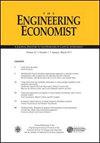On volatile growth: Simple fitting of exponential functions taking into account values of every observation with any signs, applied to readily calculate a novel covariance-invariant CAGR
IF 1.2
4区 经济学
Q4 BUSINESS
引用次数: 0
Abstract
Abstract The commonly used compound annual growth rate does not consider volatility, and its calculation fails for time series beginning or terminating with a zero or negative value, which may be the case for a company’s earnings history. Thus, a modification of the standard definition is proposed, derived from a covariance-invariant mapping of observations to a two-parameter exponential model. The novel growth rate is called “covariance-invariant “, which becomes for the special case of steady growth at a constant rate. It can be obtained using different options such as a chart, look-up table or formula. Further, the extension of the model by an additive constant may be used if negative values dominate. The approach is viewed as easy to apply as the log-linear model but with a superior performance. Compared to nonlinear least-squares regression, unique solutions can be obtained that allow a rather quick calculation.关于波动增长:指数函数的简单拟合,考虑到每个观测值的任何符号,应用于计算新的协方差不变CAGR
常用的复合年增长率没有考虑波动性,对于以零或负值开始或结束的时间序列,其计算失败,这可能是公司盈利历史的情况。因此,我们提出了一个标准定义的修改,从观测值的协方差不变映射到双参数指数模型。这种新的增长率被称为“协方差不变”,它适用于以恒定速率稳定增长的特殊情况。它可以使用不同的选项获得,例如图表,查找表或公式。此外,如果负值占主导地位,则可以使用加性常数对模型进行扩展。该方法与对数线性模型一样易于应用,但具有更好的性能。与非线性最小二乘回归相比,可以获得唯一解,允许相当快的计算。
本文章由计算机程序翻译,如有差异,请以英文原文为准。
求助全文
约1分钟内获得全文
求助全文
来源期刊

Engineering Economist
ENGINEERING, INDUSTRIAL-OPERATIONS RESEARCH & MANAGEMENT SCIENCE
CiteScore
2.00
自引率
0.00%
发文量
14
审稿时长
>12 weeks
期刊介绍:
The Engineering Economist is a refereed journal published jointly by the Engineering Economy Division of the American Society of Engineering Education (ASEE) and the Institute of Industrial and Systems Engineers (IISE). The journal publishes articles, case studies, surveys, and book and software reviews that represent original research, current practice, and teaching involving problems of capital investment.
The journal seeks submissions in a number of areas, including, but not limited to: capital investment analysis, financial risk management, cost estimation and accounting, cost of capital, design economics, economic decision analysis, engineering economy education, research and development, and the analysis of public policy when it is relevant to the economic investment decisions made by engineers and technology managers.
 求助内容:
求助内容: 应助结果提醒方式:
应助结果提醒方式:


